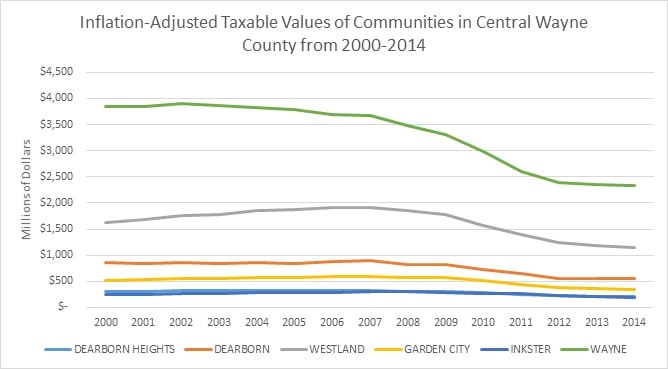A recent press conference held by Wayne County Executive, Warren Evans, has confirmed the dismal outlook for the county’s financial situation and cites a $70 million budget deficit. What is more, Evan’s administration anticipates that the county will run out of cash by May 2016 without any kind of intervention. While discussions to identify contributing factors cannot omit exploring criticisms of financial management and other administrative shortcomings, these alone cannot account for the full story.
The tax base of a county government is only as strong as the tax bases of the local governments that lie within it. Michigan Department of Treasury data reveals that local governments within Wayne County have seen an average 17.6 percent loss of taxable value in real dollars since 2000. Indeed, no local government in Wayne County, as of 2014, has been able to return to the taxable values seen prior to the collapse of the housing bubble in 2008. On average, these municipalities have been able to recapture approximately 67 percent of peak values by 2014. A valid reply to this may be to suggest that the figures just prior to the recession are an inappropriate point of comparison due to the artificial pricing that is characteristic of any commodity experiencing bubble price rises. However, even when comparing to the taxable values seen in 2000, 40 percent (17 of 43) of local governments in Wayne County have yet to recapture those figures in terms of nominal dollars and only 19 percent (8 of 43, which, with the exception of the cities of Plymouth and Northville, are all fringe townships) have been able to recapture these values when adjusting for inflation.
The first losses in terms of both nominal and real taxable value for the county as a whole were observed in 2008. Wayne County’s taxable value decline in real dollars from 2007 to 2014 was over $14.8 billion. Nevertheless, as the first graph below indicates, year to year losses in taxable values in some Wayne County local governments were seen even before the events of 2008. Furthermore, the second graph indicates that local governments in Wayne County were experiencing taxable values below levels of inflation prior to 2008 as well. Stated otherwise, communities were experiencing year to year losses of potential purchasing power. This decline in taxable value may be explained by the rapid decline of Michigan’s manufacturing base observed during this time period and the subsequent erosion of housing values.

Source: Taxable Values collected from Michigan Department of Treasury. Calculations by Citizens Research Council of Michigan. Calculations for inflation set to the year 2000 as the base year. *Out of a total of 43 local governments.

Source: Taxable Values collected from Michigan Department of Treasury. Calculations by Citizens Research Council of Michigan. Calculations for inflation set to the year 2000 as the base year. *Out of a total of 43 local governments
The devastating subsequent effect of the housing market crash on the most populous local governments in Wayne County cannot be emphasized enough. In 2008, of the 43 local governments in the county, only three (Riverview, Hamtramck, and Sumpter Township) did not experience losses in real (or inflation-adjusted) taxable value, despite only a 0.05 percent increase in the rate of inflation from the year before. Overall, the county as a whole experienced a 3.2 percent loss in taxable value. In 2009, an extremely low inflation rate assured that further losses were slightly less severe in terms of real dollars compared to the year before, with ten local governments experiencing modest gains in inflation adjusted taxable values. This, however, was short lived. From 2010 through 2012, all local governments in Wayne County except Northville Township (which experienced a modest gain from 2011 to 2012) saw losses in real taxable value. In terms of unadjusted dollars, Sumpter Township had a modest gain in 2010, while the same was true in 2012 for Northville Township, the cities of Northville and River Rouge. Average decreases over this 36 month period in real dollars were 8.1 percent.
Since 2012, only a handful of local governments (Northville, Canton, and Sumpter Townships, and the cities of Northville, Melvindale, River Rouge, Grosse Pointe, Rockwood, Plymouth, and Grosse Pointe Farms) have seen real taxable value increases from one year to the next, and even in these limited cases, on an inconsistent basis. The graphs below illustrate the losses at the county level and show that signs of trouble appeared early, in the form of decelerated year to year growths in taxable values, even in nominal dollars.
The greatest percentage losses from peak to current real values have been experienced by built out, working class communities in Wayne County. The cities of Harper Woods, Wayne, Dearborn, Westland, Romulus, Flat Rock, Lincoln Park, and Wyandotte and Redford Township, all currently have between 61 percent (Dearborn) and 47 percent (Harper Woods) of the real dollar taxable values they possessed prior to 2008. The anomaly here is the City of the Village of Grosse Pointe Shores, incorporated as a city in 2009, which has lost 57 percent of its real dollar taxable value capacity, compared to its peak in 2004. Some cities have done better than one would expect. Notably, Detroit and Hamtramck have been able to maintain 64 and 67 percent, respectively, of their peak inflation adjusted taxable values. Unexpectedly perhaps, the cities of Livonia, Dearborn Heights and Belleville find themselves between these two ranges of percentages. Wayne County’s taxable value is 66.8 percent of the peak value in 2007. Slightly over 51 percent of the local governments in the county are positioned below this figure in terms of inflation-adjusted capacity compared to peak years.
While the last two years indicate that the rate of “bleeding” may have eased, any significant resurgence is unlikely. Recent federal revenue projections from the Congressional Budgeting Office indicate that the economy will at best see only modest rates of expansion for the next decade. In Michigan, these modest gains will prove even weaker due to Headlee rollbacks and Proposal A caps. This does not bode well for Wayne County local governments that find themselves needing to provide services to residents with significantly less purchasing power than they had a decade-and-a-half ago. Other issues aside, in light of the aforementioned, it is of little surprise that Wayne County finds itself in dire financial straits.

Source: Taxable Values collected from Michigan Department of Treasury. Calculations by Citizens Research Council of Michigan. Calculations for inflation set to the year 2000 as the base year.
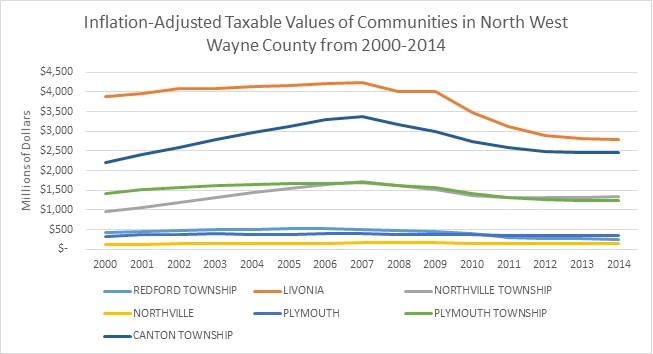
Source: Taxable Values collected from Michigan Department of Treasury. Calculations by Citizens Research Council of Michigan. Calculations for inflation set to the year 2000 as the base year.
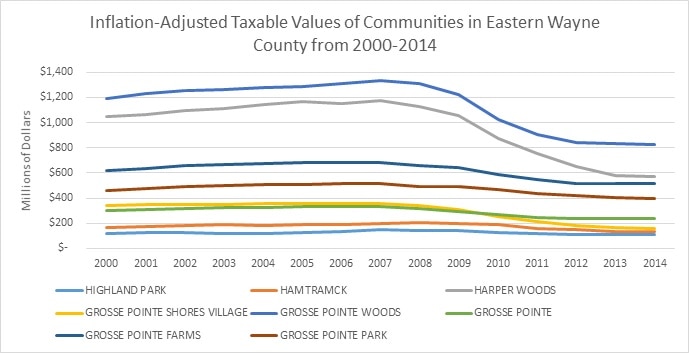
Source: Taxable Values collected from Michigan Department of Treasury. Calculations by Citizens Research Council of Michigan. Calculations for inflation set to the year 2000 as the base year.
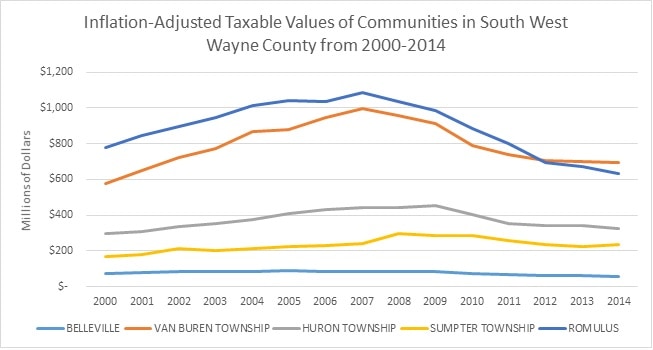
Source: Taxable Values collected from Michigan Department of Treasury. Calculations by Citizens Research Council of Michigan. Calculations for inflation set to the year 2000 as the base year.
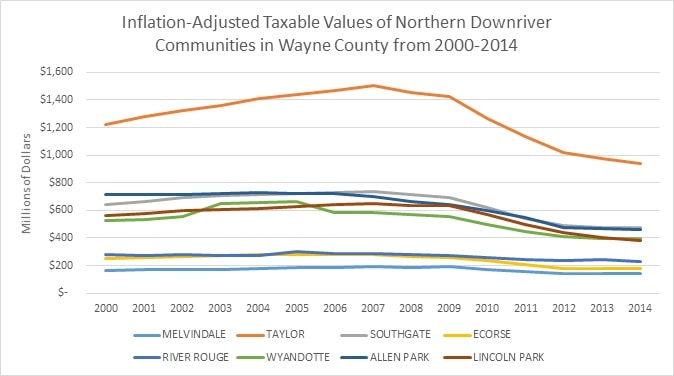
Source: Taxable Values collected from Michigan Department of Treasury. Calculations by Citizens Research Council of Michigan. Calculations for inflation set to the year 2000 as the base year.

Source: Taxable Values collected from Michigan Department of Treasury. Calculations by Citizens Research Council of Michigan. Calculations for inflation set to the year 2000 as the base year.
